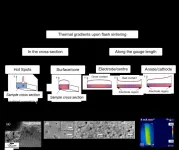The study, led by senior author Jeong Ho Lee, MD, PhD, at Korea Advanced Institute of Science and Technology and the team of Stanley Medical Research Institute, appears in Biological Psychiatry, published by Elsevier.
Traditional genetic mutations, called germline mutations, occur in sperm or egg cells and are passed on to offspring by their parents. Somatic mutations, in contrast, occur in an embryo after fertilization, and they can appear throughout the body or in isolated pockets of tissues, making them much harder to detect from blood or saliva samples, which are typically used for such sequencing studies.
Recently, more-advanced genetic sequencing techniques have allowed researchers to detect somatic mutations, and studies have shown that even mutations present at very low levels can have functional consequences. A previous study hinted that brain somatic mutations were associated with schizophrenia (SCZ), but it was not powerful enough to cement such an association.
In the current study, the researchers used deep whole-exome sequencing to determine the genetic code of all exomes, the parts of genes that encode proteins. The scientists sequenced postmortem samples from 27 people with schizophrenia and 31 control participants both from brain and from liver, heart or spleen tissue, allowing them to compare the sequences in the two tissues. Using a powerful analytic technique, the team identified an average of 4.9 somatic single-nucleotide variants (SNV), or mutations, in brain samples from people with SCZ and 5.6 somatic SNVs in brain samples from control subjects.
Although there was no significant quantitative difference in somatic SNVs between SCZ and control tissues, the researchers found that the mutations in SCZ patients were found in genes already associated with SCZ. Of the germline mutations that had previously been associated with schizophrenia, the genes affected encoding proteins associated with synaptic neural communication, particularly in a brain region called the dorsolateral prefrontal cortex.
The researchers then determined which proteins might be affected by the newly identified somatic mutations. Remarkably, a protein called GRIN2B emerged as highly affected, and two patients with SCZ carried somatic mutations on the GRIN2B gene itself. GRIN2B is a protein component of NMDA-type glutamate receptors, which are critical for neural signaling. Faulty glutamate receptors have long been suspected to contribute to SCZ pathology; GRIN2B ranks among the most-studied genes in schizophrenia.
John Krystal, MD, Editor of Biological Psychiatry, said of the work, "The genetics of schizophrenia has received intensive study for several decades. Now a new possibility emerges, that in some cases, mutations in the DNA of brain cells contributes to the biology of schizophrenia. Remarkably this new biology points to an old schizophrenia story: NMDA glutamate receptor dysfunction. Perhaps the path through which somatic mutations contribute to schizophrenia converges with other sources of abnormalities in glutamate signaling in this disorder."
Dr. Lee and the team next wanted to assess the functional consequences of the somatic mutations. Because of the location of the GRIN2B mutations found in SCZ patients, the researchers hypothesized that they might interfere with the receptors' localization on neurons. Experiments in cortical neurons from mice showed that the mutations indeed disrupted the receptors' usual localization to dendrites, the "listening" ends of neurons, which in turn prevented the formation of normal synapses in the neurons. The finding suggests that the somatic mutations could disrupt neural communication, contributing to SCZ pathology.
The somatic mutations identified in the study had a variant allele frequency of only about 1 percent, indicating that the mutations were rare among brain cells as a whole. Nevertheless, they have the potential to create widespread cortical dysfunction.
Dr. Lee said of the findings: "Besides the comprehensive genetic analysis of brain-only mutations in postmortem tissues from schizophrenia patients, this study experimentally showed the biological consequence of identified somatic mutations, which led to neuronal abnormalities associated with SCZ. Thus, this study suggests that brain somatic mutations can be a hidden major contributor to SCZ and provides new insights into the molecular genetic architecture of SCZ."
INFORMATION:
Notes for editors
The article is "Low-level brain somatic mutations are implicated in schizophrenia," by Myeong-Heui Kim, Il Bin Kim, Junehawk Lee, Do Hyeon Cha, Sang Min Park, Ja Hye Kim, Ryunhee Kim, Jun Sung Park, Yohan An, Kyungdeok Kim, Seyeon Kim, Maree Webster, Sanghyeon Kim, Jeong Ho Lee (https://doi.org/10.1016/j.biopsych.2021.01.014). It appears as an Article in Press in Biological Psychiatry, published by Elsevier.
Copies of this paper are available to credentialed journalists upon request; please contact Rhiannon Bugno at Biol.Psych@sobp.org or +1 254 522 9700. Journalists wishing to interview the authors may contact Jeong Ho Lee at jhlee4246@kaist.ac.kr or +82-42-350-4246.
The authors' affiliations and disclosures of financial and conflicts of interests are available in the article.
John H. Krystal, MD, is Chairman of the Department of Psychiatry at the Yale University School of Medicine, Chief of Psychiatry at Yale-New Haven Hospital, and a research psychiatrist at the VA Connecticut Healthcare System. His disclosures of financial and conflicts of interests are available here.
About Biological Psychiatry
Biological Psychiatry is the official journal of the Society of Biological Psychiatry, whose purpose is to promote excellence in scientific research and education in fields that investigate the nature, causes, mechanisms and treatments of disorders of thought, emotion, or behavior. In accord with this mission, this peer-reviewed, rapid-publication, international journal publishes both basic and clinical contributions from all disciplines and research areas relevant to the pathophysiology and treatment of major psychiatric disorders.
The journal publishes novel results of original research which represent an important new lead or significant impact on the field, particularly those addressing genetic and environmental risk factors, neural circuitry and neurochemistry, and important new therapeutic approaches. Reviews and commentaries that focus on topics of current research and interest are also encouraged.
Biological Psychiatry is one of the most selective and highly cited journals in the field of psychiatric neuroscience. It is ranked 7th out of 155 Psychiatry titles and 12th out of 271 Neurosciences titles in the Journal Citations Reports; published by Clarivate Analytics. The 2019 Impact Factor score for Biological Psychiatry is 12.095. http://www.sobp.org/journal
About Elsevier
As a global leader in information and analytics, Elsevier helps researchers and healthcare professionals advance science and improve health outcomes for the benefit of society. We do this by facilitating insights and critical decision-making for customers across the global research and health ecosystems.
In everything we publish, we uphold the highest standards of quality and integrity. We bring that same rigor to our information analytics solutions for researchers, health professionals, institutions and funders.
Elsevier employs 8,100 people worldwide. We have supported the work of our research and health partners for more than 140 years. Growing from our roots in publishing, we offer knowledge and valuable analytics that help our users make breakthroughs and drive societal progress. Digital solutions such as ScienceDirect, Scopus, SciVal, ClinicalKey and Sherpath support strategic research management, R&D performance, clinical decision support, and health education. Researchers and healthcare professionals rely on our 2,500+ digitized journals, including The Lancet and Cell, our 40,000 eBook titles; and our iconic reference works, such as Gray's Anatomy. With the Elsevier Foundation and our external Inclusion & Diversity Advisory Board, we work in partnership with diverse stakeholders to advance inclusion and diversity in science, research and healthcare in developing countries and around the world.
Elsevier is part of RELX, a global provider of information-based analytics and decision tools for professional and business customers. http://www.elsevier.com
Media contact
Rhiannon Bugno, Editorial Office
Biological Psychiatry
+1 254 522 9700 END




